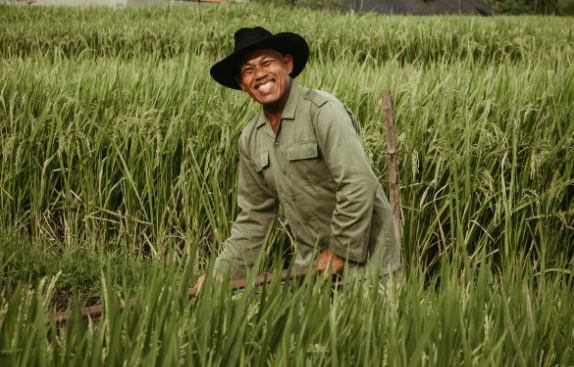


Responsible researcher: Bruno Benevit
Original title: Subsidy Policies and Insurance Demand
Authors: Jing Cai, Alain de Janvry and Elisabeth Sadoulet
Intervention Location: China
Sample Size: 3,442 families
Sector: Political Economy
Variable of Main Interest: Agricultural insurance coverage
Type of Intervention: Subsidy
Methodology: OLS, IV, RDD
Summary
Family income and consumption fluctuate in the face of different forms of risk, especially in the rural context. Formal insurance to protect against such risks, however, is not generally adopted in both developed and developing countries. This scenario implies challenges faced by several countries in expanding voluntary insurance coverage for individuals. To evaluate how subsidy policies impact crop insurance uptake, this study evaluated a subsidy policy and climate insurance education in China for rice farming households. The results showed that families who benefited from financial education permanently improve the adherence of these farmers. Conversely, farmers with little knowledge about insurance continually update their membership decisions based on recent experiences with disasters and payments.
Individuals deal with risks in different ways. The decision to opt for agricultural insurance is influenced by several factors, including the level of financial education, risk perception, previous experience with insurance, and trust in the institutions that offer these products. In many cases, low insurance valuations are related to a lack of knowledge about long-term benefits and the rarity of events that trigger insurance payments. Furthermore, economic barriers, such as the cost of policies and the availability of government subsidies, also play a crucial role (CAI; DE JANVRY; SADOULET, 2020).
Implemented government initiatives aimed at increasing uptake of agricultural insurance prioritize access to subsidies, dissemination of information and improving confidence in insurance. Evidence in the literature (BANERJEE et al., 2019; COLE et al., 2013), however, indicates low effectiveness of these policies in dealing with the way in which knowledge and experience in relation to insurance influence individuals' decisions to adhere to this protection.
According to the authors (CAI; DE JANVRY; SADOULET, 2020), there are three channels through which an initial exposure to insurance can affect the demand for insurance in the long term: (i) the direct effect of experiencing a payment, with an expected positive effect on enrollment if an insured shock occurred and a payment was received, and a negative discouraging effect if a premium was paid and no shock occurred or a shock occurred without a corresponding payment; (ii) the social effect of observing payment experiences on the network, which follows the same process of positive and negative effects in relation to stochastic payments; and (iii) a habit-forming effect, with past use of the product influencing current demand.
Rice is the most important agricultural product in China, accounting for almost 50% of the country's agricultural workforce. In this context, in 2009 the Chinese government requested the People's Insurance Company of China (PICC) to create a rice production insurance policy for rural families in order to maintain food security and protect farmers from climate shocks. Initially implemented in 31 pilot counties, the program was expanded to 62 counties in 2010 and 99 in 2011.
Rice production insurance is based on the area's yield index and covers natural disasters such as heavy rains, floods, windstorms, extreme temperatures and droughts. Unlike weather index-based insurance, payouts depend on the average loss in the area. If the yield loss is 30% or more, farmers receive payments proportional to the rate of loss, ranging from 60 RMB per mu for a 30% loss to 200 RMB per mu for a total loss.
Rice production costs are approximately 400 RMB per mu, while the average gross income is about 800 RMB per mu. The insurance covered 25% of gross income or 50% of production costs, with a fair actuarial price of 12 RMB per mu per season. The policy was sold in February, before the growing season in March. The premiums were deducted from a rice production subsidy deposited into farmers' bank accounts in January, eliminating liquidity problems. Insurance payments were deposited directly into the same bank account.
To assess the impact of subsidy policies on insurance uptake, the authors conducted a two-year field experiment between 2010 and 2011, in which subsidies were randomly awarded to 134 villages with 3,442 households in rural China. In the first year, subsidy policies occurred at the village level, where rice farmers in selected villages were offered agricultural insurance with a partial subsidy of 70% of the actuarial fair price (monthly cost of 3.6 RMB).
After the families defined adherence to the program, the experiment separated the villages into two groups: the “non-free sample” group, comprising farmers who joined the program, 72 villages received the partial subsidy initially offered, and the “non-free sample” group, comprising farmers who joined the program. free”, comprising 62 villages where all farmers received the full subsidy (regardless of program membership). The samples showed similar adherence, varying between 40% and 43%, so that insurance users in the “non-free sample” and the “free sample” covered 43% and 100% of families, respectively.
In the second year of the study, the subsidy level was randomized between 90 and 40% of the fair price at the household level, where farmers were randomly assigned a price from three price options available in their village. The program also featured a financial education program on insurance products for randomly selected farmers in 86 of the 134 sampled villages. Additionally, approximately 40% of the villages in the sample were selected for the default option, where adherence to the program was previously designated, with farmers being responsible for indicating non-adherence if they did not want the insurance.
The validity of the randomization of groups and prices was corroborated by the authors through regressions on observed characteristics of farmers, such as gender, age and education of the head of the family, family size, rice production area, risk aversion and future perception of natural disasters.
The study considered a Bayesian theoretical model to formalize the learning process. Thus, this process is impacted by the price paid in the first year through three distinct effects: (i) a reach effect, where subsidies increase adherence and, consequently, the opportunity to experience or observe payments; (ii) an attention effect, where a lower insurance cost for the individual leads to less attention to information generated by payment experiences; and (iii) a price anchoring effect, where low prices in the past reduce current willingness to pay.
To estimate the impact of the agricultural insurance subsidy policy in China, the authors conducted several ordinary least squares (OLS) regressions, verifying channels through which an initial exposure to insurance can affect the demand for insurance in the long term. Firstly, the aggregate effect of the intervention on insurance uptake was verified, estimating the demand curve for insurance prices and the impact of the total subsidy policy on rice producers.
Subsequently, the direct effect of experiencing the payment of the agricultural insurance premium was analyzed. For this analysis, the effect of benefiting from the premium payment directly and the effect of witnessing the premium payment by more than 50% of the farmer's contact network were estimated separately. In addition to the OLS method, a regression discontinuity (RDD) was also conducted around the critical point of 30% crop losses. For this analysis, only farmers who initially joined the program were considered.
To verify the existence of a long-term habit formation effect, it was observed how past receipt of premiums in the first three years and access to the financial education course affected farmers' adherence to agricultural insurance in the fourth year. To this end, a model was estimated considering the isolated effect of having received the insurance premium for each year, identified from binary variables, and the effects of receiving the premium in more than one year (1st year and 2nd year, 1st year and 3rd year, 2nd year and 3rd year, and 1st, 2nd and 3rd years). Finally, the authors carried out tests to verify the memorization of losses using a two-stage least squares model (2SLS) considering as instruments the interaction between farmers' agricultural losses and binary variables identifying farmers in the “free sample” group. , from the default and according to the price drawn in the 2nd year.
The results regarding the aggregate effects of the program revealed a 6 percentage point (pp) higher adherence rate for farmers who received a full subsidy in the first year compared to farmers who received a partial subsidy offer. The price elasticity of insurance demand was -0.44 for the program's subsidized price level (3.6 RMB). Adding covariates to the models did not significantly change the results.
Regarding the effect of receiving a premium in the first year, farmers who received a partial subsidy in the first year showed an increase in the adherence rate in the second year of between approximately 10 and 36 pp, reducing the price effect by approximately 80%. For farmers who received a full subsidy in the first year, this increase varied between approximately 5 and 17 pp. The results were significant for both empirical strategies. The results also demonstrated an increase of 20 pp in insurance adherence for farmers who did not join the program in the 1st year and witnessed the receipt of the insurance premium by other producers, and no significant effect for those who had joined in the 1st year.
The analysis regarding the identification of habit formation in the long term presented results indicating that exposure to the financial education course had an impact on farmers' adherence to insurance. The adherence of farmers who did not have financial education was only significantly positively influenced by receipt of premiums in the 3rd year, the period prior to the year analyzed (4th year), while the adherence of families who had financial education was also significantly affected by receipt of premiums in the 1st and 2nd year, indicating greater understanding of the insurance benefits on the part of these farmers.
This paper investigated the impact of subsidy policies on uptake of rice production insurance against climate shocks among farmers in China. To this end, a two-year randomized field experiment was conducted in 134 villages in the country, where partial and full subsidies were offered, in addition to a financial education program.
Evidence from this study highlighted that farmers are moderately sensitive to the level of subsidized insurance pricing. The experience of receiving an insurance premium significantly increased uptake over time, even when subsidies were reduced, highlighting the relevance of a successful initial insurance experience. Furthermore, the study highlighted the importance of farmers' perception of earnings for adherence to insurance subsidy policies. The design of this policy reveals how a better understanding of the program by policyholders can induce continued adherence in the long term, contributing to financial security and resilience in the face of climate shocks in agricultural productivity.
References
BANERJEE, A. et al. The Challenges of Universal Health Insurance in Developing Countries: Evidence from a Large-scale Randomized Experiment in Indonesia. Cambridge, MA: National Bureau of Economic Research, Aug. 2019.
CAI, J.; DE JANVRY, A.; SADOULET, E. Subsidy Policies and Insurance Demand. American Economic Review, vol. 110, no. 8, p. 2422–2453, 1 Aug. 2020.
COLE, S. et al. Barriers to Household Risk Management: Evidence from India. American Economic Journal: Applied Economics, vol. 5, no. 1, p. 104–135, 1 Jan. 2013.